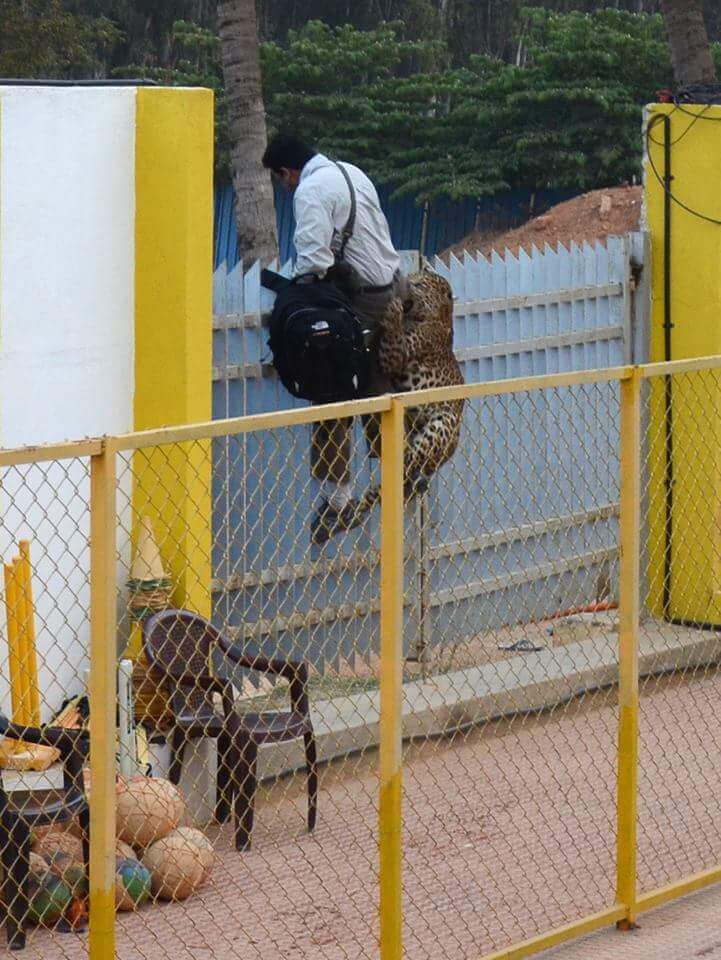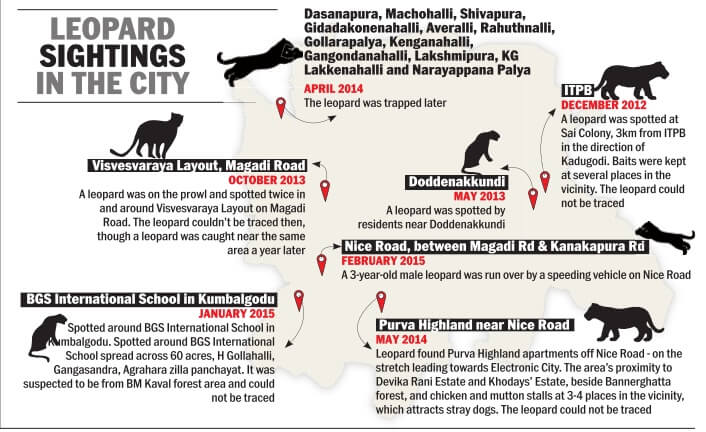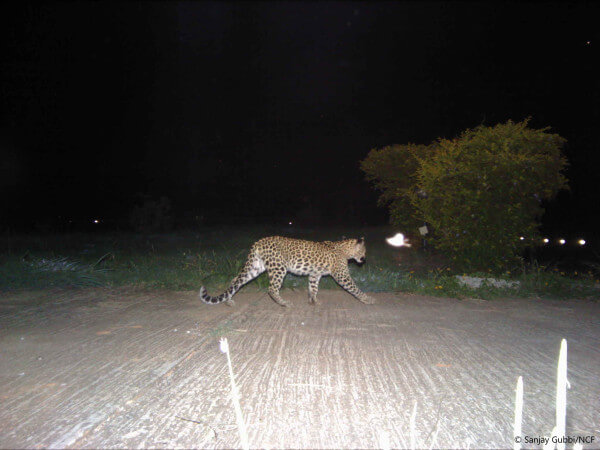Leopards in the Cities

Leopards in the Cities: How come? How to avoid an encounter? How to deal with it when you encounter one?
Leopards sometimes live quite close to human settlements, even in semi-developed areas especially so in India. These are extremely secretive animals and due to their superlative stealthiness they hide well and people often remain unaware that these big cats live in nearby areas. I have compiled a set of articles which might throw more light on the subject and also Do’s & Don’t on how to deal with leopards if you are living in the outskirts.
Also our urban idea of wilderness, that leopards only occur in forests is far disconnected from truth and the recent leopard sighting in a Bangalore school is a case in point (Also see the attached picture of several sightings of leopard in Bangalore – Courtesy Bangalore Mirror)

Leopards Among Us:
Here is an article where Sanjay Gubbi (yes, one of the victims of the recent attack in Bangalore) has camera trapped them in an apartment complex in Bangalore where the kids and the elderly who uses the same path to play/walk are completely were unaware that the same path was used by the leopards in the night:


Complete Article and more such images are here : Leopards of India’s Silicon City – Nat Geo
Leopards are Shy & nocturnal and avoid Humans:
Vidya Athreya, wildlife biologist and research associate with Center for Wildlife Studies and Wildlife Conservation Society – India programme, Bengaluru, who was part of that study, states that humans are not prey. “Leopards are comfortable carrying prey weighing 25-35 kg in their mouths. Adult humans are too large for them,” she says.
“In a majority of the instances of attacks on humans so far, the victim was crouching (to relieve himself) in bushes. To the leopard, a crouching figure would look like small and easy prey. If leopards have attacked humans who were standing, it was because the animal was surrounded by a crowd, leaving it no choice but to attack and escape,” says Athreya.
In these sessions, says Nasima, they discussed the behaviour of leopards, shy, nocturnal animals that avoid interaction with humans unless threatened, and explained why panic is counter-intuitive.
You can read more about that research here – “LIVING WITH LEOPARDS”
The Trapped Leopard left far away will come back:
The Forest Department, under pressure, traps the animals and leaves them in a nearby forest. However this only worsens the problem because of the leopard’s biology. They are highly territorial animals, and adults will not leave their homes. If such an animal is trapped and settled even 400 km away, it tries to go back home, using new areas, using human dominated areas that it is not familiar with; and with more than 300 people/ km2 in India, chances for conflict can increase. Furthermore, it is often said that they need to be culled. However, recent studies find that removal of large cats by killing can also create problems because the vacant territories are swiftly colonised by younger animals who can move in from even 100 km away. And since they are new to the area, the problems can increase.
Read more about this in this article: Living with Leopards Outside Protected Areas in India
Many Leopards live surprisingly close to human homes
The first GPS study of leopard behavior in India has revealed that many live surprisingly close to human homes without them ever noticing.
“When leopards are found outside the forest in a high-population density area, we think they have strayed. But it’s their home as much as it is ours,” said biologist Vidya Athreya from the Wildlife Conservation Society India in a press release.
“Leopards are adaptable and therefore can survive among humans unlike tigers. Human beings have drawn maps of protected area, but leopards don’t understand our boundaries,” Athreya added.
There is evidence that dumping leopards in the middle of nowhere in the hopes that they’ll stay away from human towns doesn’t work.
But the data also showed that the leopards made an effort to avoid humans on their journeys, by moving mostly at night, particularly when they were close to homes.
Read in detail about this here – GPS-collars reveal that leopards live alongside humans in India

What to do When you see a leopard on a Street?
The cat will come onto your land or property if there is food there. Keep your surroundings devoid of garbage as this attracts dogs and other livestock, which in turn attracts the leopards. Be alert especially after dark when leopards are most active. Avoid going into the thick vegetated area after dark.
“If you have to move around in the dark, ensure that you have a companion with you. Carry a torch and a stick. Play loud music, so that they will not mistake you for another animal. You see, leopards never attack people who appear bigger in size. Therefore, children, and adults sitting in a crouched position, are the people who are in the greatest potential danger. Don’t leave your kids unattended. If the cat is in your immediate area, be calm and allow it leave on its own. Don’t panic. Finally, don’t form a crowd around a leopard. Don’t scream at it or attack it. The last thing you want to do is frighten a cornered leopard, because it will make it much more likely to injure someone in a desperate bid to escape.”
Read in detail here
What to Do if You See a Leopard on the Street
Dos and Don’t’s
There are some simple things one can follow to minimize the losses we face to leopards when we live close to them.
- Ensure that your children are not alone in the dark hours in areas where leopards (or any other wild carnivores) are present
- If you have dogs then make sure they are in enclosed cages in the dark hours. The same holds true for medium-sized livestock.
- Often dogs come attracted to garbage that is not properly disposed of around your colony or a mess/canteen and leopards are attracted to the dogs. Thus effective waste disposal is crucial if you are living close to leopard use areas.
- Do not make a demand for trapping if the animal has not done anything to humans. Any amount of trapping will not remove their presence entirely and other leopards will come to use the vacant territories. Arbitrary removal can increase the problem for you.
- If you see a leopard do not threaten it, move away.
PS: Please be a responsible wildlife tourist; No littering, No sounds, No feeding, no getting down from the safari jeep (when on safari), No phone calls. Remember that we are visiting their home and when we are there, let’s follow their rules.
With 4 years of Sightings data + Extensive expert tracker network in jungles, our customers had the best wildlife experiences.
Buy Wildlife Fashion Accessories
Exclusive Online Store for wildlife products
Packages
Packages Loading...
Recent Posts









One thought on “Leopards in the Cities”
Comments are closed.